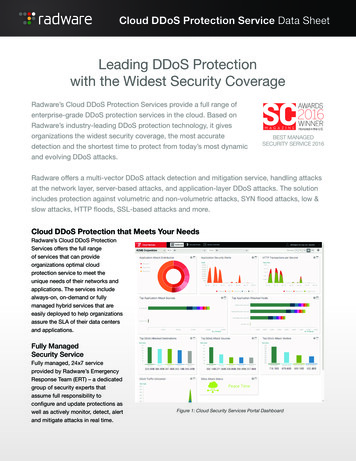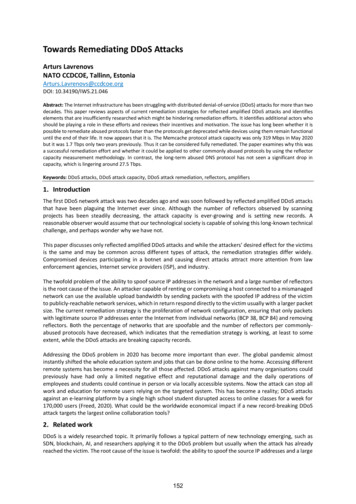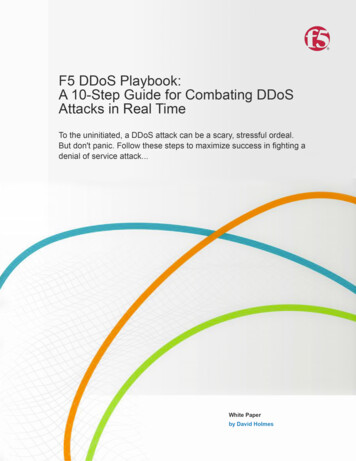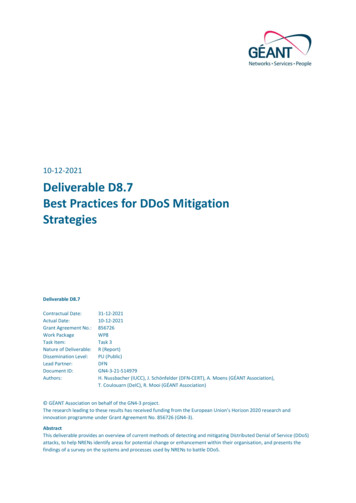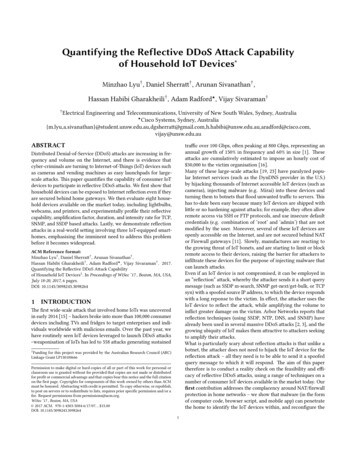
Transcription
Quantifying the Reflective DDoS Attack Capabilityof Household IoT Devices Minzhao Lyu† , Daniel Sherratt† , Arunan Sivanathan† ,Hassan Habibi Gharakheili† , Adam Radford?, Vijay Sivaraman†† ElectricalEngineering and Telecommunications, University of New South Wales, Sydney, Australia? Cisco Systems, Sydney, @cisco.com,vijay@unsw.edu.autraffic over 100 Gbps, often peaking at 800 Gbps, representing anannual growth of 150% in frequency and 60% in size [1]. Theseattacks are cumulatively estimated to impose an hourly cost of 30,000 to the victim organisation [16].Many of these large-scale attacks [19, 23] have paralyzed popular Internet services (such as the DynDNS provider in the U.S.)by hijacking thousands of Internet accessible IoT devices (such ascameras), injecting malware (e.g. Mirai) into these devices andturning them to botnets that flood unwanted traffic to servers. Thishas to-date been easy because many IoT devices are shipped withlittle or no hardening against attacks; for example, they often allowremote access via SSH or FTP protocols, and use insecure defaultcredentials (e.g. combination of ‘root’ and ‘admin’) that are notmodified by the user. Moreover, several of these IoT devices areopenly accessible on the Internet, and are not secured behind NATor Firewall gateways [11]. Slowly, manufactures are reacting tothe growing threat of IoT bonets, and are starting to limit or blockremote access to their devices, raising the barrier for attackers toinfiltrate these devices for the purpose of injecting malware thatcan launch attacks.Even if an IoT device is not compromised, it can be employed inan “reflection” attack, whereby the attacker sends it a short querymessage (such as SSDP m-search, SNMP get-next/get-bulk, or TCPsyn) with a spoofed source IP address, to which the device respondswith a long reponse to the victim. In effect, the attacker uses theIoT device to reflect the attack, while amplifying the volume toinflict greater damage on the victim. Arbor Networks reports thatreflection techniques (using SSDP, NTP, DNS, and SNMP) havealready been used in several massive DDoS attacks [2, 3], and thegrowing ubiquity of IoT makes them attractive to attackers seekingto amplify their attacks.What is particularly scary about reflection attacks is that unlike abotnet, the attacker does not need to hijack the IoT device for thereflection attack – all they need is to be able to send it a spoofedquery message to which it will respond. The aim of this papertherefore is to conduct a reality check on the feasibility and efficacy of reflective DDoS attacks, using a range of techniques on anumber of consumer IoT devices available in the market today. Ourfirst contribution addresses the complacency around NAT/firewallprotection in home networks – we show that malware (in the formof computer code, browser script, and mobile app) can penetratethe home to identify the IoT devices within, and reconfigure theABSTRACTDistributed Denial-of-Service (DDoS) attacks are increasing in frequency and volume on the Internet, and there is evidence thatcyber-criminals are turning to Internet-of-Things (IoT) devices suchas cameras and vending machines as easy launchpads for largescale attacks. This paper quantifies the capability of consumer IoTdevices to participate in reflective DDoS attacks. We first show thathousehold devices can be exposed to Internet reflection even if theyare secured behind home gateways. We then evaluate eight household devices available on the market today, including lightbulbs,webcams, and printers, and experimentally profile their reflectivecapability, amplification factor, duration, and intensity rate for TCP,SNMP, and SSDP based attacks. Lastly, we demonstrate reflectionattacks in a real-world setting involving three IoT-equipped smarthomes, emphasising the imminent need to address this problembefore it becomes widespread.ACM Reference format:Minzhao Lyu† , Daniel Sherratt† , Arunan Sivanathan† ,Hassan Habibi Gharakheili† , Adam Radford? , Vijay Sivaraman† . 2017.Quantifying the Reflective DDoS Attack Capabilityof Household IoT Devices1 . In Proceedings of WiSec ’17 , Boston, MA, USA,July 18-20, 2017, 6 pages.DOI: 10.1145/3098243.30982641INTRODUCTIONThe first wide-scale attack that involved home IoTs was uncoveredin early 2014 [15] – hackers broke into more than 100,000 consumerdevices including TVs and fridges to target enterprises and individuals worldwide with malicious emails. Over the past year, wehave routinely seen IoT devices leveraged to launch DDoS attacks–weaponisation of IoTs has led to 558 attacks generating sustained1 Fundingfor this project was provided by the Australian Research Council (ARC)Linkage Grant LP150100666Permission to make digital or hard copies of all or part of this work for personal orclassroom use is granted without fee provided that copies are not made or distributedfor profit or commercial advantage and that copies bear this notice and the full citationon the first page. Copyrights for components of this work owned by others than ACMmust be honored. Abstracting with credit is permitted. To copy otherwise, or republish,to post on servers or to redistribute to lists, requires prior specific permission and/or afee. Request permissions from permissions@acm.org.WiSec ’17 , Boston, MA, USA 2017 ACM. 978-1-4503-5084-6/17/07. . . 15.00DOI: 10.1145/3098243.30982641
Minzhao Lyu† , Daniel Sherratt† , Arunan Sivanathan† ,Hassan Habibi Gharakheili† , Adam Radford? , Vijay Sivaraman†WiSec ’17 , July 18-20, 2017, Boston, MA, 63Smart HomeSmart Home4BotnetDevices552Internet4home gateway2home eFigure 1: Internal source of attack trafficFigure 2: External source of attack traffichome gateway to expose these IoT devices to internal and externalreflection without the user’s knowledge, in effect making everyhome device a potential reflector. Our second contribution is toprofile the reflective capability of eight consumer IoT devices available today, in terms of their amplification factors, traffic capacity,and sustained durations for SSDP, TCP, and SNMP-query basedattack traffic. Our third contribution is to deploy these IoT devices in three homes equipped with different IoT devices, usingdifferent models of home gateways, and served by different ISPs, todemonstrate their combined capability to amplify a DDoS attack bya factor of 20 over a sustained 24-hour period. Our work is the firstto empirically evaluate the risk of reflection DDoS attacks usinghousehold IoT devices, pointing to the urgent need to identify andmitigate them before they cause widespread damage.The remainder of the paper is organized as follows: §2 summarizesrelevant prior work on DDoS attacks. In §3 we show how malwarecan penetrate the NAT/firewalls in home gateways to expose household IoT devices as reflectors, while in §4 we quantify the strengthof reflective DDoS attacks from numerous consumer IoT devices.We demonstrate the aggregation of reflection attacks from our labsetup as well as three households and quantify its performance in§5, and conclude the paper in §6.Prior works have only considered reflection agents publicly accessible over the Internet, while we additionally show that consumer IoTdevices secured behind home gateways can also be exposed. Further, prior works have largely focused on measuring reflections ofsingle packets, while we quantify sustained attacks from individualIoT devices as well as aggregated households.23EXPOSING HOUSEHOLD IOT DEVICESAS REFLECTORSAttackers today commonly use publicly available services such asDNS and NTP as reflectors [13]. While the high traffic capacityof such servers makes them attractive as reflectors, their limitednumber makes them easier to safeguard. By contrast, household IoTdevices individually have low traffic capacity, but their aggregationin large numbers can easily sustain very high attack volumes, making them attractive agents for the next wave of reflection attacks.The presence of home gateways with NAT/Firewall offers some protection to household IoT devices from being used as reflectors, butin this section we show that this protection can be circumventedrelatively easily, making real the risk that tens of millions of suchdevices can become reflection agents.Our attack is inspired by prior work that has shown that it isrelatively easy to inject malware into downloaded software [18],browser plug-ins [9], and mobile apps [8], that the user can reasonably be expected to be running within their home inside of thehome gateway. Specifically, [9] has shown that malicious scriptscan be embedded in browser extensions to send packets on thehome network, and [20] has shown that a malicious mobile app(approved by Apple) can discover IoT devices within the home andconfigure port forwarding on the home gateway to allow externalaccess to these devices. We now describe two methods by whichsuch malware can expose household IoT devices as reflectors toattackers.The first (and somewhat naive) method is depicted in Fig. 1. In step1 our malware scouts for reflection-vulnerable UDP ports (1900SSDP, 161 SNMP) and common TCP ports (22 SSH, 23 Telnet, 80RELATED WORKMethods for reflective DDoS attacks have been studied in the research literature. The work in [6, 24] identifes 14 different UDPbased protocols related to network services (SSDP, SNMP, DNS,NTP, NetBios), legacy protocols (CharGen, QOTD), P2P (BitTorrent,Kad) and Gaming (Quake 3, Steam) that can be reflected and amplified. Kührer et al [12] scan and discover publicly accessible Internetdevices, including servers, home routers, and embedded devicesthat respond to UDP reflection requests. The work is extended in[14] to include attacks based on 13 common TCP-based protocols(FTP, HTTP, IPP, IMAP, SSH, etc.) – and about 2% of over 20 millionhosts scanned on the Internet were found to have an amplificationfactor greater than 20x.2
Quantifying the Reflective DDoS Attack Capabilityof Household IoT Devices2Device TypeSamsung smart camWemo power switchPhilips Hue lighbulbBelkin NetCamHP ENVY 5540 printerWemo motion sensorSmartThings hubWithings Smart sleep sensorWiSec ’17 , July 18-20, 2017, Boston, MA, USASSDP Reflection SNMPv1 Reflection SNMPv2c edUnsupportedUnsupportedUnsupportedTable 1: Protocol vulnerability and amplification factorsHTTP, 443 HTTPS) on IoT devices that are present in the home network. It then transfers collected information to the outside attackerin step 2 . Upon receiving a trigger message from the attacker (step3 ), our malware in step 4 becomes part of the botnet that generates IP-spoofed traffic (by forging the packet header so it containsa victim’s address as sender) to IoT devices inside the local homenetwork. The IoT devices will respond (step 5 ) to amplify andreflect these packets to the victim machine in the Internet.Though the attack above is feasible (as demonstrated later in thispaper), it has some limitations. Firstly, IP-spoofing is not possible insome platforms – for instance, Apple iOS does not allow developersto access and modify raw packet information. Secondly, this attackrelies on the insider botnet device (containing the malware) to bepresent and online in the home network. On the flip side, the reflection sourced from an internal botnet can be quite efficient since anUDP-based query can be broadcasted to multiple IoT devices in thehome network, triggering them all to reply to the victim, therebyachieving high amplification.A more sophisticated version of our attack is shown in Fig. 2, whichrequires an one-off action from the malware to identify and expose household IoT devices to external botnets. The malware firstdiscovers IoT devices in the house (step 1 ) as before. It then reconfigures the home gateway using an UPnP SOAP command (step2 ) to enable port-forwarding, so that query packets from the Internet get forwarded to a specific port of appropriate IoT devicein the home that responds to (and amplifies) the query. This willbe demonstrated in subsequent sections for multiple IoT devicesacross multiple home gateway models. Our malware then informsthe attacker in step 3 on the public IP address, protocols and portnumbers to use for reflecting attacks from this house. The attackerinstructs botnet devices (step 4 ) to source traffic towards this house(step 5 ), which the household IoT devices now amplify and reflectto the victim on the Internet (step 6 ).4TCP SYN Reflection55665546runs OpenWrt firmware release Chaos Calmer (15.05.1, r48532) andserves as the gateway to the Internet. We wrote Python script thatemulates the malware, running on a Macbook Air laptop connectedto the LAN side of the home router. Our attacker is an Ubuntumachine (running a PHP script), the victim is a Windows7 laptop,and the external botnet device is a Kali Linux desktop (runningpython script), all of which are directly connected to the campusnetwork offering public IP addresses.4.1Attack AmplificationOur first attack is from the internal botnet, which sends a broadcastM-SEARCH request for SSDP, and get-next request for SNMPv1 (asbroadcast request), get-bulk request for SNMPv2c (as broadcastrequest), and unicast SYN packet for TCP. For the TCP reflectionscenario, we inhibit the victim from sending a RST packet to thereflector (which is the likely case when it is overloaded with DDoSattack traffic [14]), which makes the reflector retransmit the TCPSYN-ACK repeatedly (4-6 times for the IoT devices we used).Each IP-spoofed packet generated by the botnet device causesone (in the case of SNMP) or many (in the case of SSDP and TCP)packets to get reflected to the victim. Table 1 shows reflection types(SSDP refleciton, SNMPv1 reflection, SNMPv2c reflection and TCPSYN reflection) supported by each IoT device considered, alongwith their amplification factor where applicable, which is the ratioof size(s) of reflected packet(s) to the size of the original spoofedrequest packet. It is seen that all eight IoT devices considered canreflect TCP SYN packets, though the amplification factor is relatively low in the range of 4-6 (arising from retransmissions of theSYN-ACK). SNMP is reflected by only two of eight devices considered,again with a relatively low amplification factor, with the SNMPv2get-bulk being more effective than the SNMPv1 get-next request.SSDP, supported by half the devices considered, by far yields thehighest amplification: for example the Belkin NetCam and Wemomotion sensor amplify attacks by factors of 43.3 and 27.47 respectively. This is because the SSDP response typically contains deviceinformation including IP address, name, UUID, management URL,functionalities, etc.; this information can vary among devices, forexample the Philips Hue lightbulb’s response is about one third ofthe Belkin NetCam’s in bytes.We also verified that the same attacks work from an external botnet,once the malware has crafted UPnP packets to enable port forwarding on the home gateway. The amplification factors are identical,the only difference being that in the case of SSDP and SNMP theQUANTIFYING THE REFLECTIONCAPABILITYWe evaluate traffic reflection using the attack models presented inthe previous section applied to eight consumer IoT devices: theseinclude the Samsung smart camera[21], Wemo power switch[5],Wemo motion sensor[5], Philips Hue lighbulb[17], Belkin NetCam[4],HP ENVY 5540 printer[10], SmartThings hub[22], and WithingsSmart sleep sensor[25], all chosen as they have fairly high adoptionamong consumers today. In our laboratory setup all IoT devicesare connected to a TP-Link home router model Archer C7 v2 that3
Minzhao Lyu† , Daniel Sherratt† , Arunan Sivanathan† ,Hassan Habibi Gharakheili† , Adam Radford? , Vijay Sivaraman†WiSec ’17 , July 18-20, 2017, Boston, MA, USA80020Avg. rate received by victim (Kbps)Reflected rate (Kbps)Input rate: 0.5 KbpsInput rate: 1 Kbps151050-50100200300400Time (sec)5005004003002001000180Avg. rate received by victim (Kbps)Input rate: 10 KbpsInput rate: 13 Kbps300250200150100500100200300400Time (sec)5101520Figure 5: Input/Output average rate in sustained UDP reflection attack350Reflected rate (Kbps)600Avg. rate generated by botnet (Kbps)Figure 3: Reflected SSDP traffic pattern of Philips Hue 506070Avg. rate generated by botnet (Kbps)Figure 4: Reflected SSDP traffic pattern of Wemo powerswitchFigure 6: Input/Output average rate in sustained TCP reflection attackM-SEARCH, get-next,get-bulk requests have to be unicast messages (addressed to the home gateway’s public IP address on theappropriate port) rather than a LAN broadcast.(SSDP or SNMP). We therefore subject these devices to the appropriate UDP traffic at increasing rate. Fig. 3 shows a time-series ofthe reflected rate from the Philips Hue lightbulb when subjected totwo SSDP query rates: when the request rate is 0.5 Kbps, it reflectsat around 5 Kbps (dashed red line in plot) and when subject to 1Kbps it reflects at 12 Kbps (solid blue line). The resulting sustainedamplification is therefore around 10-12, which is slightly lower thanthe amplification of 15 obtained from a single packet (as reportedin Table 1, signifying that the efficacy of amplification can fall athigher rates. Indeed, when we increased the query rate above 1Kbps, the reflected traffic rate and traffic pattern over time do notchange, signfying that the device has saturated in its ability to sustain the rate.In Fig. 4 we show the reflected traffic pattern from the Wemo powerswitch when subjected to SSDP queries. When the query rate isaround 10 Kbps, the device is able to sustain a reflection rate ofaround 220 Kbps, corresponding to an amplification factor of around4.2Sustaining AttacksIoT devices are resource-constrained, and we do not expect themto be able to amplify arbitrary volumes of attacks. In this sectionwe therefore quantify the maximum rate and duration for whicheach IoT device can sustain a reflection attack. We subject eachIoT device to bombardment of attack traffic at various rates for aduration of 10 minutes (by adjusting the inter-packet delay andusing multi-threading where needed), and observe how its reflectedtraffic pattern and amplification change with time and traffic rate.UDP-based Reflection: One may note from Table 1 that eachIoT device considered supports at most one of the UDP protocols4
Quantifying the Reflective DDoS Attack Capabilityof Household IoT Devices3WiSec ’17 , July 18-20, 2017, Boston, MA, USA1.4InternetHouse OneASUSDSL-N55U1.2Throughput (Mbps)AttackerPhilips LightHue BulbWithingsSleep SensorSamsung SmartCam1TPGVictimBotnets0.8AARNETVictim (external botnet)Botnet (external botnet)Victim (internal botnet)Botnet (internal botnet)0.60.4House TwoNetgearDGN20000.20TP-LinkWR1043NDWemoSwitchWemo SensorSmartThings HubBelkin NetCamHP ENVY 5540 Printer010203040Time (Minutes)50TelstraHouse Three60Figure 8: Residential deploymentFigure 7: Aggregated attack traffic from external and internal botnets1.4victim 1.2Throughput (Mbps)22 (consistent with the number of 24 reported on a per-packet basisin Table 1). However, in this case increasing the query rate furthercauses the device to falter – the figure that at an input rate of 13Kbps, the device reflects traffic for only about 30 seconds before itbecomes unresponsive (itself becoming a victim of a DoS attack!),and requires around 100 seconds to recover back before the cyclerepeats. As astute attacker would know the rate to which a devicecan be pushed so as to sustain the DDoS attack over longer periods.Fig. 5 summarizes the ability of each IoT device considered to sustain attacks, by plotting the average reflected traffic rate (receivedby victim) as a function of the average input traffic rate (generatedby botnet) – the slope of each curve is indicative of the amplificationfactor. Devices such as the Samsung SmartCam (using SNMPv2c),Philips lightbulb (using SSDP), and HP printer (using SNMPv1)saturate in their ability to reflect attacks (at respective input ratesof 140, 0.7 and 15 Kbps), while other devices such as the BelkinNetcam, Wemo motion sensor, and Wemo power switch (all usingSSDP) drop markedly in their rate when subject to input traffic inexcess of 13, 10, and 10 Kbps respectively.10.8home3 0.60.4home2 0.2home1 05pm11pmbotnet 5am11am5pmTimeFigure 9: Reflected aggregated traffic pattern20 Kbps (approximately 2 and 1 respectively) are much lower thanexpected from Table 1, indicating that the state maintenance inTCP imposes a higher burden on the IoT device, leading to muchlower amplification for TCP compared to UDP traffic. Attacks usingUDP are therefore more effective, except when the IoT device doesnot support any UDP reflection (such as the Smart Things hub andWhithing sleep sensor).TCP-based Reflection: Table 1 indicates that a TCP SYN packetsent to an IoT device gets amplified by a factor of 4-6. However, experimentation revealed that six of the eight IoT devices consideredcould not sustain even a few Kbps of TCP SYN requests, and theirreflected attack rates never exceed 20 Kbps (i.e. SmartThings hub,Wemo power switch, Wemo motion sensor, Samsung SmartCam,Belkin Netcam and Philips Light Hue bulb are not able to generatesustained attack rates more than 0.3, 0.7, 0.8, 1.9, 13 and 16 Kbpsrespectively), as depicted in Fig. 6. This is because these IoT devicesare not able to maintain more than a few concurrent connectionsopen, possibly because their memory resources get exhausted, andsize of each TCP SYN-ACK packet is relatively small (i.e. aboutseveral tens of Bytes). The figure also shows that the HP Printer(black dotted line) and the Whithings sleep sensor (green dottedline) are the only ones that can sustain higher reflection rates; however, their amplification factors when reflected average rates exceed5AGGREGATED REFLECTIVEDDOS ATTACKHaving quantified the individual reflection capabilities of the eightconsumer IoT devices, we deployed them in aggregate, first in thelab, and then distributed across three homes (belonging to authorson this paper), in order to validate their combined behavior in thereal-world.5
Minzhao Lyu† , Daniel Sherratt† , Arunan Sivanathan† ,Hassan Habibi Gharakheili† , Adam Radford? , Vijay Sivaraman†WiSec ’17 , July 18-20, 2017, Boston, MA, USA5.1attacks. While we cannot proffer a ready solution, attempts at limiting the network behavior of IoT devices [7] are worth considering.Lab EnvironmentAll eight IoT devices are connected to a home gateway in our lab,and attack traffic is generated first from internal and then fromexternal botnets. The internal botnet is able to broadcast its SSDPqueries (to address 239.255.255.250) and SNMP v1/v2c requests(to address 192.168.0.255 in our setup), while for the external botnet appropriate port forwarding rules are enabled by the malwareto direct queries as unicasts to each device. For the SSDP reflection, the standard M-SEARCH is a broadcast request, our botnetdevice instead sends unicast UDP packets with the same payload asM-SEARCH request to get it routed to the home gateway. We didnot make an overly great effort to optimize the query rates to eachspecific device – our results in the previous section indicate thatevery device we considered can sustain input traffic of 10 Kbps, sowe kept the rate uniform at this number for UDP and TCP requestsacross all devices.In Fig. 7 we show the average reflected traffic rate received by thevictim (a computer on campus) over an 1-hour period, and find it tobe roughly 1.1 Mbps for both internal and external botnet attacks.The external botnet traffic rate is around 50 Kbps (corresponding toan amplification of over 20), while the internal botnet rate is a lotlower at 20 Kbps, since it broadcasts its queries on the home LAN,giving it a higher amplification factor of over 100.5.2REFERENCES[1] Arbor Networks. 2017. Insight into the Global Threat Landscape. bal-threat-landscape. (2017).No end in sight for DDoS attack size[2] Arbor Networks. -KNA-087/images/WISR Infographic NoEndInSight FINAL.pdf. (2017).[3] B. Prince. 2015. DDoS Attacks Using SSDP Spike in Q1: Arbor Networks. p-spike-q1-arbor-networks.(2015).[4] Belkin International, Inc. 2017. NetCam HD Wi-Fi Camera with Night -F7D7602. (2017).[5] Belkin International, Inc. 2017. Wemo Switch Motion. http://www.belkin.com/au/p/F7C027au/#Features. (2017).[6] C. Rossow. 2014. Amplification Hell: Revisiting Network Protocols for DDoSAbuse. Network and Distributed System Security Symposium (2014).[7] Cisco Systems. 2016. Manufacturer Usage Description Framework. k-00.pdf. (2016).[8] A. P. Felt, M. Finifter, E. Chin, S. Hanna, and D. Wagner. 2011. A Survey ofMobile Malware in the Wild. Proceedings of the 1st ACM Workshop on Securityand Privacy in Smartphones and Mobile Devices (2011), 3–14.[9] S. Heule, D. Rifkin, A. Russo, and D. Stefan. 2015. The Most Dangerous Codein the Browser. Proceedings of the 15th USENIX Conference on Hot Topics inOperating Systems (2015), 23–23.[10] HP Development Company, L.P. 2017. HP ENVY 5540 Wireless All-in-OnePrinter. http://store.hp.com/ukstore/merch/product.aspx?opt ABU&sel prn&id J6U66A. (2017).How the Internet of Things took down[11] J. Condliffe. internet/. (2016).[12] M. Kührer, T. Hupperich, C. Rossow, and T. Holz. 2014. Exit from Hell? Reducingthe Impact of Amplification DDoS Attacks. Proceedings of the 23rd USENIXConference on Security Symposium (2014), 111–125.Attackers use NTP reflection in huge DDoS[13] L. Constantin. 2014.attack. dos-attack.html. (2014).[14] M. Kuhrer and T. Hupperich and C. Rossow and T. Holz. 2014. Hell of a Handshake: Abusing TCP for Reflective Amplification DDoS Attacks. USENIX Workshop on Offensive Technologies (2014).Proofpoint uncovers Internet of[15] Market Watch. 2016.Things (IoT) 2014-01-16. (2016).[16] Arbor Networks. 2017. DDoS: The Stakes Have Changed. Have You? TechnicalReport.[17] Philips Lighting B.V. 2017. Philips Hue bridge. s-hue-bridge. (2017).[18] N. Provos, D. McNamee, P. Mavrommatis, K. Wang, and N. Modadugu. 2007. TheGhost in the Browser Analysis of Web-based Malware. Proceedings of the FirstConference on First Workshop on Hot Topics in Understanding Botnets (2007), 4–4.[19] S. Khandelwal. 2016. Friday’s massive DDoS attack came from just 100,000hacked IoT devices. -iot.html. (2016).[20] V. Sivaraman, D. Chan, D. Earl, and R. Boreli. 2016. Smart-Phones AttackingSmart-Homes. Proc. ACM WiSec (2016).[21] SmartCam. 2017.SmartCam Products: SNH-P6410BN.https://www.samsungsmartcam.com/web/. (2017).[22] SmartThings, Inc. 2017. Samsung SmartThings Hub. /hubs-and-kits/samsung-smartthings-hub. (2017).[23] T. Seals. 2017.Leet IoT Botnet Bursts on the Scene with Massive DDoS leet-iot-botnet-bursts-on-the-scene/. (2017).[24] United States Computer Readiness Team. 2014. UDP-based amplification 17A/. (2014).[25] Withings SA. 2017. Sleep Sensor Accessory. -sensor-accessory. (2017).Residential EnvironmentWe now distributed our IoT devices across three households (belonging to the authors), as depicted in Fig. 8, each having a differenthome gateway (ASUS, Netgear, and TP-Link) and a different ISP.Python scripts were executed in each household to emulate themalware that discovered available reflective ports of householddevices and enabled port forwarding on the respective gateways,and the attacker was hosted on an Ubuntu machine, a Kali Linuxmachine located on campus representing an external botnet device.Fig. 9 shows the traffic sourced from the botnet device (the bottomblack line, averaging at just under 60 Kbps), and the traffic reflectedfrom each of the three houses to the victim was measured (home-1green line 0.14 Mbps, home-2 light-blue line 0.42 Mbps, home-3dark-blue line 0.6 Mbps), and found to total 1.16 Mbps (top red line).Further, this amplification of around 20 was sustained for 24 hoursfrom 5pm on 6 Feb 2017 till 5pm on 7 Feb 2017.6CONCLUSIONSThis paper has explored the feasibility and efficacy of DDoS attacksthat use consumer IoT devices as reflectors. We have shown thathome gateways can be bypassed by malware inside the home to expose IoT devices as reflectors to external botnets. We have profiledthe reflective power of eight popular consumer IoT devices in termsof their amplification factors and sustained rates. We have deployedthese IoT devices in real homes to amplify an attack by a factor of20 to inflict 1.2 Mbps of unwanted traffic on an Internet victim for24 continuous hours. It is not inconceivable in the near future that8 million (rather than just eight) IoT devices, mistakenl
Cisco Systems, Sydney, Australia fm.lyu,a.sivanathang@student.unsw.edu.au,dgsherra , vijay@unsw.edu.au ABSTRACT Distributed Denial-of-Service (DDoS) a acks are increasing in fre-quency and volume on the Internet, and there is evidence that )devicessuch as cameras and vending machines as easy .


